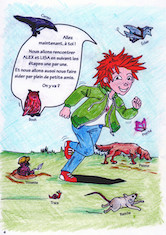![]() In my My Archaeology Book, there are many animals which accompany Augustin and his archaeologist friends Alex and Lisa. Unveil the secrets of the animals from My Archaeology Book for children from 5 to 16 years old, thanks to this page in which you will find a list presenting the animals, their names and their function.
In my My Archaeology Book, there are many animals which accompany Augustin and his archaeologist friends Alex and Lisa. Unveil the secrets of the animals from My Archaeology Book for children from 5 to 16 years old, thanks to this page in which you will find a list presenting the animals, their names and their function.
Animals secrets of My Archaeology Book
 Children would have certainly noticed the many different animals which come with the different situations in My Archaeology Book. The choice of these animals as well as the choice of their name is not an arbitrary one. Each name and each animal can be seen in relation to the step it represents and a quality that our young archaeologists must possess to one day look like their elders.
Children would have certainly noticed the many different animals which come with the different situations in My Archaeology Book. The choice of these animals as well as the choice of their name is not an arbitrary one. Each name and each animal can be seen in relation to the step it represents and a quality that our young archaeologists must possess to one day look like their elders.
Organisation of the table
The table contains four rows. The first three ones are self-explanatory. The fourth one, entitled “Page” deals with the pages’ number in both versions of My Archaeology Book. The numbers standing before the slash are for My Archaeology Book 5-8 years old and the numbers standing after the slash are for My Archaeology Book 8 years old and more. The numbers written in fat are the pages in which the animals are mentioned or where their role is represented at its most importance.
List of the animals’ names and their reason for being
| Animal | Name | Reason of the name | Page |
| Eagle | Piercy | A golden eagle has a piercing eyesight eight times more than humans. Piercy illustrates the visual quality that archaeologists must have when they make aerial survey. Indeed, it needs a warning glance to detect, from a plane, traces of human occupancy left on the ground. | 9 / 2, 11, 60 |
| Hamadryas baboon | Thoth | The moon god Thoth of ancient Egypt was recognized as the inventor of writing and therefore hold knowledge. It could be represented by a baboon hamadryas or sacred ibis. Here our Thoth illustrates the knowledge and know-how that archaeologists should demonstrate to use digital tools intelligently (as on page with Lisa using Google Earth to locate the pyramid of Cheops, look at Step 2.3). | 8, 39 / 10, 47 |
| Cat | Bastet | The goddess Bastet of ancient Egypt was a quiet and gentle divinity, associated with the home, motherhood and music; the opposite of the lioness goddess Sekhmet who embodies the fierce aspects. Just like at home, our Bastet observes the places and people by ensuring quietly on the remains preserved in museums. Please note, it can turn into Sekhmet if visitors or thieves threaten collections. | 35, 39 / 42-43, 47 |
| Bat | Radar | Bats are gifted with an incredibly performant echolocation system, which helps them with spatial orientation. Radar represents one of the functioning characteristics of a detection tool for geophysics used by archaeologists, which facilitates the localisation of vestiges normally invisible by the human eye because of basements. | 10 / 12 |
| Dog | Sniffer | Due to its keen sense of smell, the dog is used in many situations: hunting, find missing people, detect illicit products, etc. His nose allows it to follow the tracks to find what is sought. Sniffer symbolizes skill that archaeologists should have to go up a trail of clues that will make them discover a new human occupancy. | 4, 7 /8, 60 |
| Crow | Cortex | The crow is a bird of great intelligence, capable of reflection and organization of ideas. By human beings, the cerebral cortex is the part responsible for highly developed functions. Cortex symbolizes the skills that archaeologists should demonstrate to understand and analyse the outcomes of excavations or inventory. | 4, 20, 29 / 26, 35, 60 |
| Dolphin | Dona | Dolphins are social and intelligent marine mammals, which have an echolocation system allowing them to spatial orientation. Dona (variant of the Celtic male name Don which means deep) illustrates the activities of archaeologists under the sea as the use of sonar to locate the remains as well as the required teamwork for an archaeological research. | 17, 34 / 22-23 |
| Snail | Trace | A snail deposits a mucus while it moving, and leaves a trace of its passage. By its slowness, it’s also an animal used to symbolize patience. Trace illustrates both the patience archaeologists must demonstrate in their research, and by a word play, traces of the remains they want. | 9 / 2, 11, 60 |
| Owl | Boo | Nocturnal animal, owl stays up and acts during the night. If it’s fear, it is also an effective guardian of our European imagination. Boo represents the act of watching over our cultural heritage in order to avoid robberies and destruction such as archaeologists who participate in the defense of our cultural heritage. | 3, 37 / 45, 61 |
| Jaguar | Clio | The jaguar is an endangered species that must be protected. In ancient Greece, the muse Clio ensure respect and protection of History. Our Clio (female jaguar) ensure that cultural heritage does not fall into oblivion and not be plundered. | 3, 37 / 45, 61 |
| Hare | Presto | The hare is a fast and clever animal. Presto illustrates the rapid transmission of information by land (Flash engaged in the air). It’s a way to show that information should not remain in a notebook or a device but must flow. | 7 / 8, 60 |
| Butterfly | Psyche | Psyché is the name of a butterfly family scientifically called Psychidae. It’s also a word of Greek origin meaning “soul” which was illustrated, in Greek mythology, Psyche by the princess, wife of Eros. Psyche illustrates the love that we have for cultural heritage. | 4, 14 / – |
| Pigeon | Flash | Through the ages, the pigeon was used as a messenger (carrier pigeon). Flash transmits information through the air that is why he have a backpack while the Presto makes it by land. It’s a way to show that information should not remain in a notebook or a device but must flow. | 4, 15 / 19, 60 |
| Rat | Gnasher | The rat is an intelligent animal gifted with many faculties, who quickly learns and lives in large families. Gnasher symbolizes learning skills, thinking and team work necessary for archaeologists to do their jobs effectively. | 4, 13, 24, 31, 38, 48 / 30, 34, 37, 47, 61 |
| House mouse | Musculus | The house mouse is called scientifically Mus Musculus. To reinforce the idea that the brain must be muscled, to allow knowledge and know-how to arrive at the right result, we chose musculus to partner with Gnasher to illustrate the capacity of reflection that archaeologists must show in the analysis of remains left by our ancestors. | 13, 28 / 16, 34, 37, 31, 63 |
| Mole | Diggy | The mole is burrowing mammal often associated with archaeological research because it digs and regularly rises to the surface buried things. Diggy therefore illustrates archaeologists’ activities: the search that reveals the buried human remains. | 3, 16 / 20 |
| Toucan | Toccata | The toucan is a bird producing slam with his tongue and beak living among others in Guatemala. Toccata helps Clio to protect archaeological sites by warning of the arrival of intruders through its beak snaps. Its name is a nod to the musical form toccata (Italian toccare, touch) which the most famous is the Toccata and Fugue in D minor for organ by Johann Sebastian Bach. | 5 / 4 |
| Snake | Narco | The common lanceheads or fer-de-lance are snakes coming from the Viperidae family. They are excellent swimmers and skillful climbers, which makes them very dangerous. They can measure up to 2 meters long and their head is of triangular shape. They live in tropical forests. His name is a nod to its venom and to dealers of all kinds, including antiques dealers. Narco represents the scavengers who only care about the vestiges of cultural heritage to make money. Thankfully, Clio and Toccata are keeping a close eye on him. | 5 / 4 |



